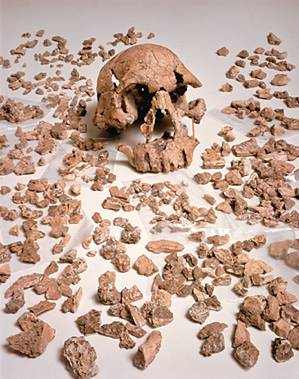
Too many of us today are still under the impression that evidence for human Evolution from hominid ancestors is dug up whole. Probably due to the pretty reconstructions in so many museums and galleries, a good many people think that the “evidence” – say, for a skull, or cranium – is displayed in the same general condition as when it was unearthed. Especially with regards to the fossil record concerning human Evolution this is never the case. In the photo above you see the over 300 fragments that were put together to “form the skull” of Homo rudolfensis in the center. We do not have to think long to realize that when we allow for glue, clay, silicon, and the human imagination, we can create reconstructions that look very real, but which are hardly alone indicative of theoretical accuracy. Here, another example:

The Truth about the origin of Man still being our goal, I mention this here because this “problem of assembly” has not been discussed often enough in the literature, and its implications have a direct bearing on our inquiry as to the antiquity of Man.
Indeed, a paralysis of some kind has apparently gripped anti-Evolutionists and Evolutionists alike. Perhaps for fear of being labeled ignorant, or being too put off by the mathematical and conceptual intricacies involved in defending the position, none of them wants to walk up to the Leakeys and their disciples and tell them that they have not yet whatsoever found anything conducive to discovering the origin of Man.
When it comes to the considering of archaeological finds we must, then, indict science for concentrating too heavily on the intricacies of detail at the expense of common sense, simple logic, and the basic rules of cause and effect. Instead of taking the fossil evidence for what it is, too much is read into it, usually in attempt to have it fit a pre-set scheme, perhaps a theory in need of substantiation. Who knows how much similar conjecture has also gone into our present translations of cuneiform, hieroglyphics, the ancient Mesoamerican scripts, and the so many other “dead language” symbols, for which we rely on similar scholarly interpretations.
This process of compensation is, by analogy, no different than learning about alternative mathematics, or space-time calculus, but forgetting how to add and subtract. Common sense tells me if you give me a bag of odd pieces of bone, and allow me the option of using other materials to form the missing pieces and adjust existing ones, then I can create you whatever I envision. I could just mold a normal head any way I like then glue on the bones here and there. There is also that lack of strength in numbers. Logic tells me that if you have some pieces of an alleged race of pre-human creatures, you should be able to find a plethora of them, and certainly more than one or two; it is highly unlikely we found the last one before the species’ extinction. And, cause and effect tells me that we tend to find only what we look for.
So as we start this section, I think it imperative that we keep an eye out for over-zealousness with regards to Science’s evaluation of the actual physical fossil evidence for human evolution. As for macroevolution, a.k.a. Evolution, and its claim that we have descended from “lower” creatures, let us state for comparison’s sake the opposite of that theory, which would claim that human beings have always been human beings, always the same. This argument would say that while people may have changed some incidental traits (hair color, eyes, build, etc.), due perhaps to some type of, as they say, microevolution or evolution, these alterations are themselves indicative of only Homo Sapiens’ global and genetic dispersals, and his adaptation to the local environmental factors, including those products of his own invention. None of this is a sufficient condition to indicate our descent from any other creature.
Continuing our survey, we are now at about the second or third step up in the artist’s illustration below, the most recent Australopithecus.
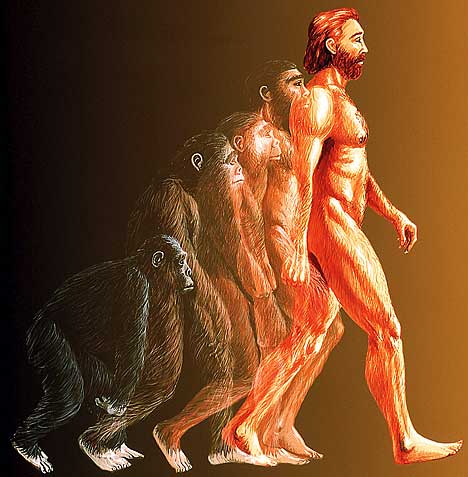
The Taung Baby and Australopithecus Africanus
The last consensus australopithecine we will discuss is Australopithecus africanus, first discovered in 1924 by Raymond Dart and colleagues in southern Africa. Subsequent finds have been made in the same general area in 1936, 1948, 1992, and 1999. Luckily, we can take a look at much of the evidence from the digs. Here are the fossils of the first and most famous africanus specimen, also known as the “Taung Child” or Taung Baby“:
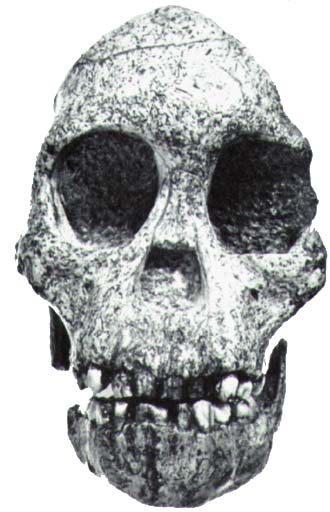
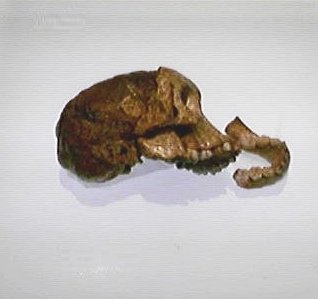
Note that these are reassembled actual fossils. The fact that this partial skull is thought to have belonged to a child is noteworthy:
The teeth of this skull showed it to be from an infant about 5 or 6 years old [it is now believed that australopithecines matured faster than humans, and that the Taung child was about 3]. [ibid.]
This is important because in all appearances the Taung kid looks like the skull of a baby ape of some kind. We read that Australopithecines “..mature faster than humans”, but how can that be known, from the existing evidence? Without knowing the full stature of a mature example, without having a long series of bones at various stages of growth, by what miracle do we confirm such speculation?
Interesting, too, is that some anthropologists speak of “a hole” found in a piece of this skull (I have not been able to see this actual hole clearly anywhere yet…). There has been much scurrying about concerning how this juvenile died, occupying much government-funded science time. And they say the schleiermachers were silly for trying to figure out the angelic order, and what God wears on Sundays.
The result of this soap opera, and with all intended seriousness, theories have been put forth by our crackerjack scientists that it was killed by a giant cat – or was it maybe maybe a bird – this latter article also makes the suggestion that the Taung africanus specimen shows all the marks of a “baboon killed by an eagle” (ibid.), and if I had to vote, I’d choose that one.
Here are some comparison collages I’ve made to illustrate the obvious simian characteristics of Taung baby:
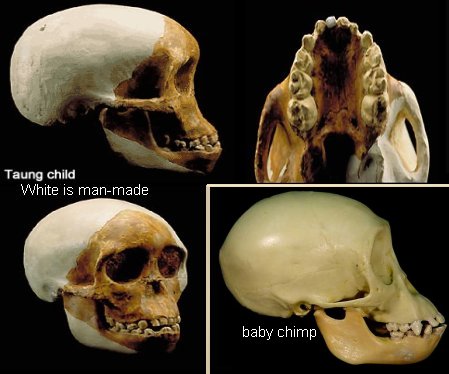
This above is three views of the reconstructed Taung baby, and a comparison view of a baby chimpanzee. Do not think I am saying Taung is a chimp, all I mean to imply is that it is awfully similar to a chimp, which makes me think it is something like a chimp. Once again this is a reconstruction and not the actual skull and face, the brown represents the fossil after its “assembly” (note the cracks are not present), the white, scientists’ further addenda. Were we to adjust for proper angle, the extant parts of the inset top left would differ from the chimp in mainly two characteristics. One is the brow ridge height as measured from the top of the eye sockets. This is of little import because the chimp’s construction actually looks more advanced. The second is the shape of the canines, which would not be fully developed, or could have decayed. Were more bondo added to the chin and jaw, it would be a near identical chimp juvenile. If this africanus is not just a regular chimpanzee ancestor, or a simian hybrid, the comparison allows us to see just one other possibility of what this creature might be. Below, I give another collage in illustration:
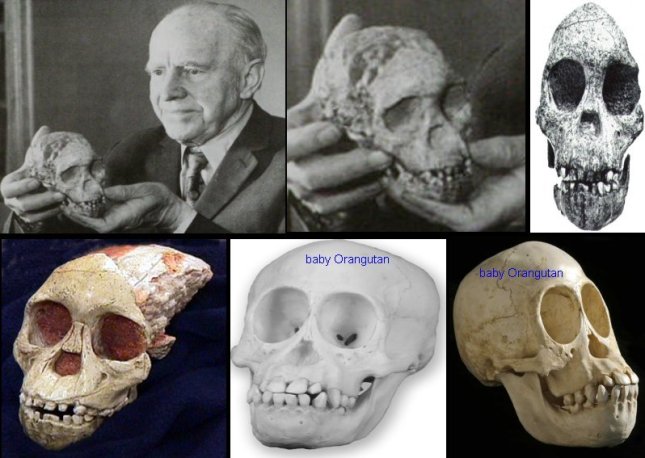
Let us not oversimplify this. There are differences in dentition, mandible set, cranium shape, thickness, and position, and many other factors that need to be taken into consideration when comparing simian and hominid skulls. But even in this picture, which also shows how small the actual skull is, we can see nevertheless a strong resemblance to another member of the ape family, in this case an adolescent orangutan. Differences in ages, wear and tear on the parts, ravages of time…when all these things are considered, and we account for variations of skull types as we would for any species, we must consider what evidence, other than the actual “face”, makes this being a proto-human and not a baby orangutan ancestor.
Dart claimed that the Taung Child was bipedal due to the position of the foramen magnum, which was pointed downward and nearly at the central balance point of the skull. In addition, the canine teeth were relatively short. In both of these traits, the Taung child was much more like a human than an ape. (source)
The teeth being short, as we have said, can be accounted for by the age of the ape. It would not have been born with long incisors and canines. Also, the base of the skull where the foramen magnum would be is simply too incomplete to be conclusive evidence of an upright posture. There is even some question as to the foramen magnum‘s being an indicator of upright stature at all.
Here are the best of the rest of the important fossils associated with this species. Most were found by Robert Broom in the period 1936-1947 at Sterkfontein in South Africa:
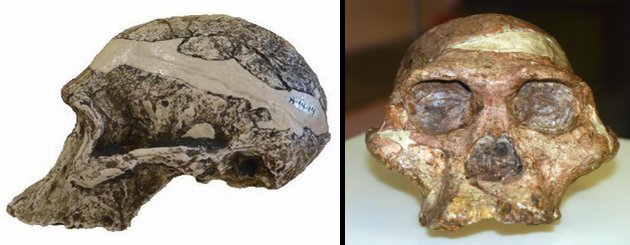
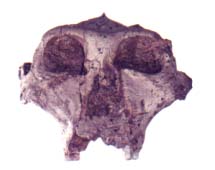
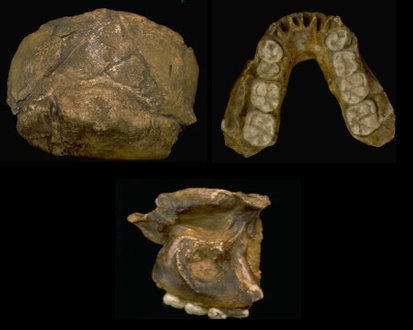
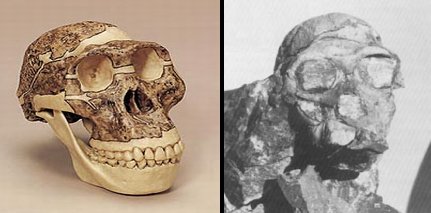
The two views of the top skull in this trio, I believe named “Mrs. Ples”, was discovered in 1947. Notice the band of material which goes around the skull. This is filler, man-made stuff, and could conceivably push the cranium in any desired position. The next one down came from Broom’s work in 1936, third from the top reconstructions of reconstructions, the two at the bottom, from 1947. Compare the actual find of this lower duo, in black and white on the right, and the reconstructed model on the left. We have created just about everything, even its lower jaw and teeth.
As it turns out, the Taung Baby has now been “firmly established” as part of the ape family, and not of the hominid line (last paragraph). At least some Science is in agreement that these creatures in this africanus line are, like the other australopithecines, apes and not Men. As usual, though, this does not stop the Artist Conceptions from being generated. Oh yes, we have ideas about what it looked like, actually, several.
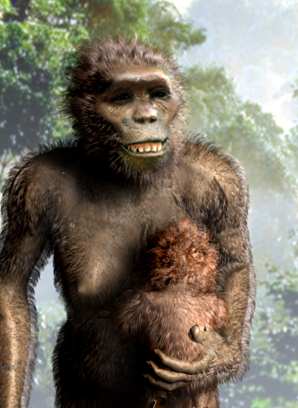
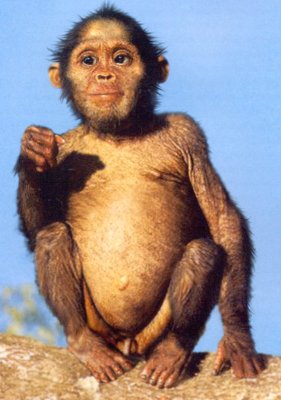

I wanted to get into what science considers the true hominid line today, but doesn’t look like we’ll get there. We have established enough for my conscience at least that the entire Australopithecus line, called “our remotest ancestors”, are really nothing of the kind. If anything, they seem to show how long apes have been apes, and my guess is as long as Man has been Man. In some sense this is why they are classified as an entirely separate genus. They exist at all where the origin of Man is concerned because for the Evolutionary system to work, we need to have come from some other type of creature, and these scraps of conjecture often fit the bill.
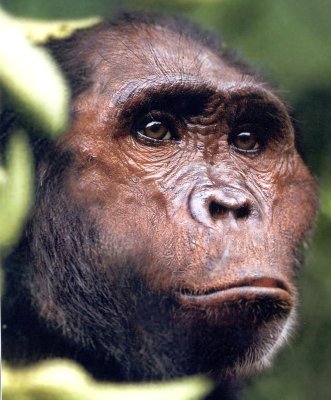
Yet one more africanus reconstruction
We have already seen that so far science has just been monkeying around with us. Let’s see if the discoveries from more recent times are offered with a greater degree of seriousness.
Edited 2-2019



